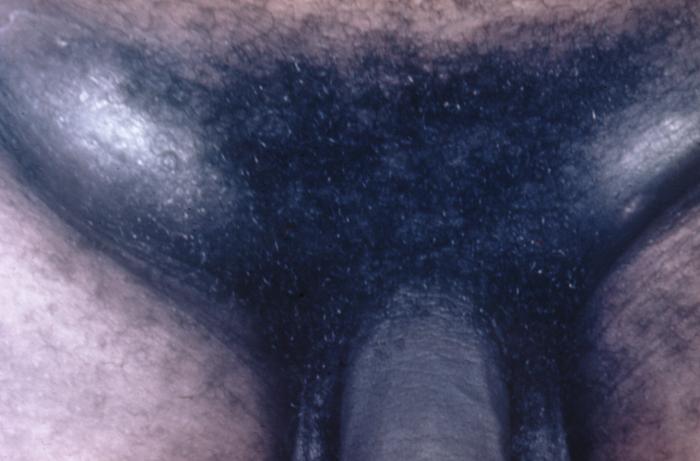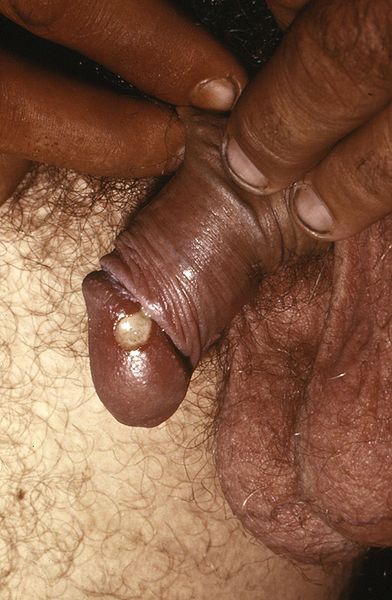Chancroid physical examination: Difference between revisions
Gerald Chi- (talk | contribs) mNo edit summary |
No edit summary |
||
| Line 7: | Line 7: | ||
==Physical Examination== | ==Physical Examination== | ||
About half of infected men have only a single ulcer. Women frequently have four or more ulcers, with fewer symptoms. The ulcers appear in specific locations, such as the coronal sulcus of the uncircumcised glans penis in men, or the fourchette and labia minora in women. | |||
===Common locations in men (from most common to least common)=== | |||
*[[Foreskin]] (prepuce) (most common) | |||
*Groove behind the head of the penis ([[coronal sulcus]]) | |||
*Shaft of the penis | |||
*Head of the penis ([[glans penis]]) | |||
*Opening of the penis (urethral meatus) | |||
*[[Scrotum]] (least common) | |||
===Common locations in women=== | |||
In women the most common location for ulcers is the [[labia majora]]. "Kissing ulcers" may develop. These are ulcers that occur on opposing surfaces of the labia. Other areas such as the [[labia minora]], [[perineum|perineal]] area, and inner thighs may also be involved. The most common symptoms in women are pain with urination and pain with intercourse. | |||
The initial ulcer may be mistaken as a "hard" [[chancre]], the typical sore of primary [[syphilis]], as opposed to the "soft chancre" of chancroid. | |||
Approximately one third of the infected individuals will develop enlargements of the [[inguinal]] [[lymph nodes]], the nodes located in the fold between the leg and the lower abdomen. | |||
Half of those who develop swelling of the inguinal lymph nodes will progress to a point where the nodes rupture through the skin producing draining abscesses. The swollen lymph nodes and abscesses are often referred to as buboes. | |||
===Skin=== | ===Skin=== | ||
Revision as of 19:26, 21 January 2016
|
Chancroid Microchapters |
|
Diagnosis |
|---|
|
Treatment |
|
Case Studies |
|
Chancroid physical examination On the Web |
|
American Roentgen Ray Society Images of Chancroid physical examination |
|
calculators and risk factors for Chancroid physical examination |
Please help WikiDoc by adding content here. It's easy! Click here to learn about editing.
Overview
Physical Examination
About half of infected men have only a single ulcer. Women frequently have four or more ulcers, with fewer symptoms. The ulcers appear in specific locations, such as the coronal sulcus of the uncircumcised glans penis in men, or the fourchette and labia minora in women.
Common locations in men (from most common to least common)
- Foreskin (prepuce) (most common)
- Groove behind the head of the penis (coronal sulcus)
- Shaft of the penis
- Head of the penis (glans penis)
- Opening of the penis (urethral meatus)
- Scrotum (least common)
Common locations in women
In women the most common location for ulcers is the labia majora. "Kissing ulcers" may develop. These are ulcers that occur on opposing surfaces of the labia. Other areas such as the labia minora, perineal area, and inner thighs may also be involved. The most common symptoms in women are pain with urination and pain with intercourse.
The initial ulcer may be mistaken as a "hard" chancre, the typical sore of primary syphilis, as opposed to the "soft chancre" of chancroid.
Approximately one third of the infected individuals will develop enlargements of the inguinal lymph nodes, the nodes located in the fold between the leg and the lower abdomen.
Half of those who develop swelling of the inguinal lymph nodes will progress to a point where the nodes rupture through the skin producing draining abscesses. The swollen lymph nodes and abscesses are often referred to as buboes.
Skin
Genital
-
Chancroid. Adapted from Dermatology Atlas.[1]
-
Chancroid. Adapted from Dermatology Atlas.[1]
-
Chancroid. Adapted from Dermatology Atlas.[1]
-
Chancroid. Adapted from Dermatology Atlas.[1]
-
Chancroid. Adapted from Dermatology Atlas.[1]
-
Chancroid. Adapted from Dermatology Atlas.[1]
-
Chancroid. Adapted from Dermatology Atlas.[1]
-
Chancroid. Adapted from Dermatology Atlas.[1]
-
Chancroid. Adapted from Dermatology Atlas.[1]
-
Chancroid infection has spread to the inguinal lymph nodes, which have enlarged forming buboes.
-
Penile chancroid lesion.
![Chancroid. Adapted from Dermatology Atlas.[1]](/images/6/6f/Chancroid01.jpg)
![Chancroid. Adapted from Dermatology Atlas.[1]](/images/c/c1/Chancroid02.jpg)
![Chancroid. Adapted from Dermatology Atlas.[1]](/images/1/1a/Chancroid03.jpg)
![Chancroid. Adapted from Dermatology Atlas.[1]](/images/7/70/Chancroid04.jpg)
![Chancroid. Adapted from Dermatology Atlas.[1]](/images/2/22/Chancroid05.jpg)
![Chancroid. Adapted from Dermatology Atlas.[1]](/images/d/d6/Chancroid06.jpg)
![Chancroid. Adapted from Dermatology Atlas.[1]](/images/1/19/Chancroid07.jpg)
![Chancroid. Adapted from Dermatology Atlas.[1]](/images/6/60/Chancroid08.jpg)
![Chancroid. Adapted from Dermatology Atlas.[1]](/images/4/4b/Chancroid09.jpg)

